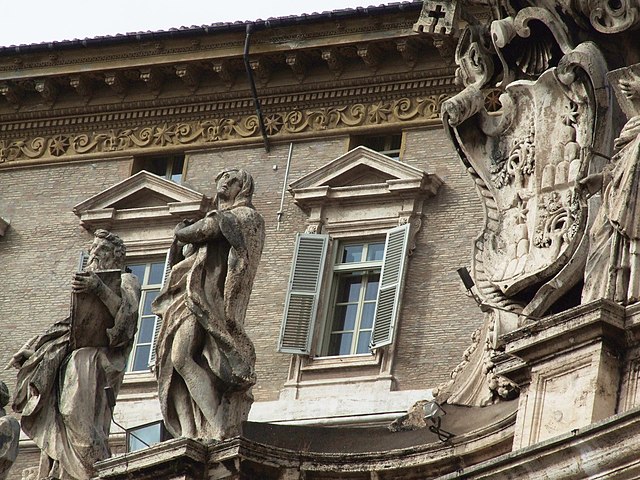Papal apartments
Non-official designation for the apartments of the Apostolic Palace in Vatican City From Wikipedia, the free encyclopedia
The papal apartments is the non-official designation for the collection of apartments, which are private, state, and religious, that wrap around a courtyard (the Courtyard of Sixtus V, Cortile di Sisto V)[1] on two sides of the third (top) floor[2] of the Apostolic Palace in Vatican City.[3][4]

Since the 17th century, the papal apartments have been the official residence of the pope in his religious capacity (as supreme pontiff). Prior to 1870, the pope's official residence in his temporal capacity (as sovereign of the Papal States) was the Quirinal Palace, which is now the official residence of the president of the Italian Republic. The papal apartments are referred to in Italian by several terms, including appartamento nobile and appartamento pontificio.[1]
Facilities
The apartments include about ten rooms consisting of a vestibule, a small studio office for the papal secretary, the pope's private study, the pope's bedroom in the corner of the building, a medical suite (which includes dental equipment and equipment for emergency surgery), a dining room, a small living room, and a kitchen.[4] There is a roof garden and staff quarters for the housekeepers. It is from the window of his small study that the pope greets and blesses pilgrims to Saint Peter's Square on Sundays.[3][4] The private library has been described as a "vast room with two windows overlooking Saint Peter's Square." The pope's private chapel occupies the top storey on the east side of the Cortile di Sisto V.
Residency
The pope usually lives at the papal apartments except for the months of July to September, when the Papal Palace of Castel Gandolfo is the official summer residence.[3] Three of the last six popes, John XXIII, John Paul I, and John Paul II, died in the papal apartments; the fourth, Paul VI, died at Castel Gandolfo; the fifth, Benedict XVI, died at Mater Ecclesiae Monastery, his home since after his resignation in 2013; and the sixth, Francis, died at Domus Sanctae Marthae, where he lived throughout his pontificate.[5][6]
The last Pope to take residence at the Papal Apartments was Pope Benedict XVI from 2005 to 2013, when he moved to Mater Ecclesiae Monastery after his resignation.
Renovations
Summarize
Perspective
The papal apartments are customarily renovated according to each new pope's preferences.
Prior to the renovation in 2005, following the death of Pope John Paul II and the election of Pope Benedict XVI, the papal apartments had reportedly been in disrepair, with "outmoded furnishings and lack of lighting" and large drums placed in the false ceiling to catch water leaks. The 2005 renovation, carried out over three months while Benedict was in summer residence at Castel Gandolfo, included the building of a new library to accommodate Benedict's 20,000 books (placed in exactly the same order as in his previous residence), upgrading the electrical wiring (125-volt electrical outlets, phased out in Italy years prior, were replaced with 220-volt outlets) and plumbing (new pipes were installed to replace those "encrusted with rust and lime").[4] The heating system was repaired and the kitchen was refurbished, reportedly with new ovens, ranges, and other appliances donated[2] by a German company. The floors, which are 16th-century marble slabs and inlay, were restored.[4] The medical studio ("hastily installed in the papal lodgings for the ailing John Paul II") was renovated and expanded to include dental facilities,[2] and the papal bedroom was completely redone. Wallpaper and other furnishings were put in throughout. The project was carried out by over 200 architects, engineers, and workers.[4] Benedict also moved personal possessions to the papal apartments, including an upright piano.[3]
Transfer
On 21 October 2016, the Vatican announced that the Palace of Castel Gandolfo would now open to the general public as part of a museum. The palace was the final part of the papal apartments to open to the public over a two-year period.[7]
See also
References
Wikiwand - on
Seamless Wikipedia browsing. On steroids.
